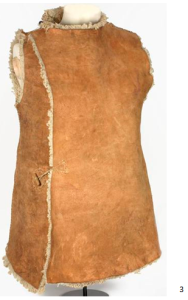Monday, February 15, 1915
On Board H.M. Transport “Australind,” (Captain Sidney Angell)
The Battalion War Diarist wrote for this day: “French men-of-war came out to escort ships into port of St. Nazaire, France. Warped into interior harbour, and made fast in afternoon. Orders that no one was to be permitted ashore without pass. O.C. landed to report. Advance party of 50 under Lieut. R.W. Frost left by train for railhead. Short goatskin coats served out to men.” [1]
THIS DAY IN RMR HISTORY: “Early on the morning of February 15th French destroyers picked up the Australind and escorted her into the outer harbour of St. Nazaire, where the Canadian Division was to land. Shortly after noon, the Australind passed through a narrow lock into the inner harbour and docked at a wharf, opening with no barrier onto a street of the town. Naturally the French city interested the men greatly, particularly as the townspeople welcomed the ship by tossing up onto the decks oranges, sweets and other tokens of good will. Enthusiasm doubled when the good citizens found that a number of the men on board spoke French and were, actually of French descent. The arrival in France of British troops who claimed France as the land of their forefathers was an event appealing to that sense of the dramatic which is the birthright of the Gaul. Unfortunately, or fortunately, perhaps, if one regards the matter from a military point of view, strict orders kept the troops from landing and accepting much proffered hospitality, and His Majesty`s Transport regulations prevented the friendly citizens from bringing their offerings on board.
At about 3:30 p.m. unloading of the Australind began, numerous working parties of the 14th taking part in the consequent fatigues. In the evening goatskin trench coats, fingerless gloves, and mufflers were issued… Unloading continued throughout the night and was completed about dawn.” [2]
 GOAT-SKIN JACKETS: Goat skins jackets were issued to British and Canadian troops in late 1914 and early 1915. Their use was, reportedly, a double edged sword as their warmth value was traded off against their attractiveness to fleas and lice. Given the miserable conditions of those winters many soldiers preferred to itch and scratch rather than shiver and die of hypothermia. Not being worn next to the skin they were relatively easy to treat with an anti-lice powder. When wet, they smelled terribly.
GOAT-SKIN JACKETS: Goat skins jackets were issued to British and Canadian troops in late 1914 and early 1915. Their use was, reportedly, a double edged sword as their warmth value was traded off against their attractiveness to fleas and lice. Given the miserable conditions of those winters many soldiers preferred to itch and scratch rather than shiver and die of hypothermia. Not being worn next to the skin they were relatively easy to treat with an anti-lice powder. When wet, they smelled terribly.
There seem to have been many patterns – some sleeveless jerkins and others full, half, and three quarter length coats, but apparently no standardized pattern. Sheep skin and fur jackets were still being issued in the winter of 1916 -1917. Some of these were much like the sheepskin jackets in vogue during the 1960s – skin outside fleece inside.
According to Sergeant Harold Baldwin, 1st Division, C.E.F., [5th Bn. Western Cavalry, Saskatchewan] in his book, Holding the Line, “…the goatskin coats were a gift from the then Czar of Russia and were supposed to have come from China. When we had donned our gift coats there was a perceptible murmur of comment running from the end to end of the ranks, caused by the odor from the presents of the Czar not unlike the presence of a skunk. Examination disclosed that the bloody (literally) coats were dotted in many places with the actual flesh of the deceased animals still sticking to them….” [4]
[1] War Diary, 14th Canadian Battalion, The Royal Montreal Regiment, Feb 15, 1915. Library and Archives Canada, Ottawa, http://data2.collectionscanada.ca/e/e044/e001089694.jpg
[2] R.C. Featherstonhaugh, The Royal Montreal Regiment 14th Battalion C.E.F. 1914-1925, Montreal, The Gazette, Printing Co., Ltd., 1927, pp.25-26.
[3] Imperial War Museum; http://www.iwm.org.uk/collections/item/object/30097862
[4] Sergeant Harold Baldwin, “Holding The Line,” as quoted at http://1914-1918.invisionzone.com/forums/index.php?showtopic=156369

